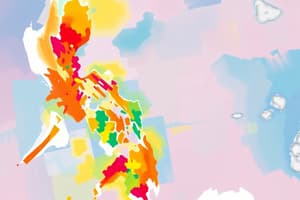Podcast
Questions and Answers
What are the main island groups that make up the Republic of the Philippines?
What are the main island groups that make up the Republic of the Philippines?
- Mindanao, Visayas, Negros
- Samar, Leyte, Mindanao
- Luzon, Palawan, Visayas
- Luzon, Visayas, Mindanao (correct)
Who named the Philippines and during what time period did this occur?
Who named the Philippines and during what time period did this occur?
- An indigenous leader prior to Spanish colonization
- A Spanish governor named the islands in 1580
- A Spanish explorer during his 1542-1546 trip (correct)
- A European artist during the Renaissance period
Which form of Philippine literature describes fictitious narratives explaining the origin of things?
Which form of Philippine literature describes fictitious narratives explaining the origin of things?
- Chants
- Folk Songs
- Legends (correct)
- Epics
What type of literature includes songs used for rites or rituals?
What type of literature includes songs used for rites or rituals?
Which of the following best describes 'Anting-anting' in the context of Philippine culture?
Which of the following best describes 'Anting-anting' in the context of Philippine culture?
Study Notes
Geographic and Political Overview
- The Republic of the Philippines is a sovereign state located in Southeast Asia.
- It consists of 7,641 islands, predominantly categorized into three major island groups: Luzon, Visayas, and Mindanao.
- The total land area exceeds 300,000 square kilometers.
Historical Naming
- A Spanish explorer named Ruy López de Villalobos named the islands after King Philip II of Spain during his expedition from 1542 to 1546.
Pre-colonial Philippines Culture
- Pre-colonial culture was influenced by unique geographical features and the diverse experiences of its inhabitants.
- Various forms of traditional narratives existed, such as:
- Chants: Often used in witchcraft or enchantments, sometimes containing mystical elements.
- Legends: Fictitious stories explaining the origins of various entities, places, or names, usually imparting moral lessons.
- Folk Tales: Narratives involving life experiences, love stories, horror, and humor.
- Epics: Series of heroic achievements or events centered around a significant hero, often involving supernatural forces.
- Folk Songs: Utilized in rituals and rites, reflective of the cultural practices of a community.
Themes in Traditional Narratives
- Traditional stories often sought to convey lessons about life, reflecting the beliefs and values of the community.
- "Anting-anting" refers to protective charms believed to grant magical powers or protection, commonly found in the folklore.
Studying That Suits You
Use AI to generate personalized quizzes and flashcards to suit your learning preferences.
Related Documents
Description
Test your knowledge about the Republic of the Philippines with this quiz. Explore its geography, regional divisions, and historical background. Discover interesting facts about its islands and their significance.



